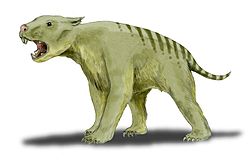| Zygomaturus Temporal range: | |
|---|---|
 | |
| Skeletal mount of Zygomaturus trilobus at the Melbourne Museum | |
 | |
| Restoration of Z. trilobus | |
| Scientific classification | |
| Kingdom: | Animalia |
| Phylum: | Chordata |
| Class: | Mammalia |
| Infraclass: | Marsupialia |
| Order: | Diprotodontia |
| Family: | † Diprotodontidae |
| Subfamily: | † Zygomaturinae |
| Genus: | † Zygomaturus Macleay, 1857 |
| Species | |
| |
Zygomaturus [2] is an extinct genus of giant marsupial belonging to the family Diprotodontidae which inhabited Australia from the Late Miocene to Late Pleistocene.
Contents
- Description
- Palaeobiology
- Evolution and extinction
- Related genera
- References
- Further reading
- External links



